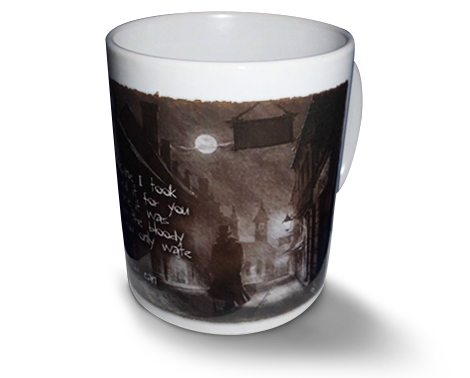Ripper victims personalised mug
11oz Jack the ripper victims mug
brief review of the Jack the Ripper murders that occurred in London more than a hundred years ago. Much of the original evidence gathered at the time has been lost, and many "facts" are actually opinions by the various writers who have written about the case during the past century. Many aspects of the case are therefore contested, and so what follows is a summation of the case in general. There are many books available to the student of crime who wishes to grapple with the many mysteries associated with the case.
"Jack the Ripper" is the popular name given to a serial killer who killed a number of prostitutes in the East End of London in 1888. The name originates from a letter written by someone who claimed to be the killer published at the time of the murders. The killings took place within a mile area and involved the districts of Whitechapel, Spitalfields, Aldgate, and the City of London proper. He was also called the Whitechapel Murderer and "Leather Apron."
Significance and Importance
Jack the Ripper has remained popular for a lot of reasons. He was not the first serial killer, but he was probably the first to appear in a large metropolis at a time when the general populace had become literate and the press was a force for social change. The Ripper also appeared when there were tremendous political turmoil and both the liberals and social reformers, as well as the Irish Home rule partisans tried to use the crimes for their own ends. Every day the activities of the Ripper were chronicled in the newspapers as were the results of the inquiries and the actions taken by the police. Even the feelings of the people living in the East End, and the editorials that attacked the various establishments of Society appeared each day for both the people of London and the whole world to read. It was the press coverage that made this series of murders a "new thing", something that the world had never known before. The press was also partly responsible for creating many myths surrounding the Ripper and ended up turning a sad killer of women into a "bogey man", who has now become one of the most romantic figures in history. The rest of the responsibility lies with the Ripper. He may have been a sexual serial killer of a type all too common in the 1990s, but he was also bent on terrifying a city and making the whole world take notice of him by leaving his horribly mutilated victims in plain sight. Lastly, the Ripper was never caught and it is the mysteries surrounding this killer that both add to the romance of the story and creating an intellectual puzzle that people still want to solve.
The Victims
It is unclear just how many women the Ripper killed. It is generally accepted that he killed five, though some have written that he murdered only four while others say seven or more. The public, press, and even many junior police officers believed that the Ripper was responsible for nine slayings. The five that are generally accepted as the work of the Ripper are:
Mary Ann (Polly) Nichols, murdered Friday, August 31, 1888.
Annie Chapman, murdered Saturday, September 8, 1888.
Elizabeth Stride, murdered Sunday, September 30, 1888.
Catharine Eddowes, also murdered that same date.
Mary Jane (Marie Jeanette) Kelly, murdered Friday, November 9, 1888.
Besides these five there are good reasons to believe that the first victim was really Martha Tabram who was murdered Tuesday, August 7, 1888, and there are important considerations for questioning whether Stride was a Ripper victim. As to the actual number of women that the Ripper killed, Philip Sugden wrote in his excellent book, The Complete History of Jack the Ripper, "There is no simple answer. In a sentence: at least four, probably six, just possibly eight."
All five of these listed plus Tabram were prostitutes and were killed between early August and early November 1888. All but Tabram and Kelly were killed outdoors and there is no evidence to suggest that any of them knew each other. They varied in both age and appearance. Most were drunk or thought to be drunk at the time they were killed.
Method of Operation
Surprisingly, a full understanding of the Ripper's modus operandi was not established until several years ago. The Whitechapel murderer and his victim stood facing each other. When she lifted her skirts, the victim's hands were occupied and was then defenseless. The Ripper seized the women by their throats and strangled them until they were unconscious if not dead. The autopsies constantly revealed clear indications that the victims had been strangled. In the past some writers believed that the Ripper struck from behind when the victims were bent forward, their skirts hiked up their backsides while waiting to engage in anal sex. This is a very awkward arrangement and the risk that they may scream or elude his clutch's make this unacceptable. The Ripper then lowered his victims to the ground, their heads to his left. This has been proven by the position of the bodies in relation to walls and fences that show that there was virtually no room for the murderer to attack the body from the left side. No bruising on the back of the heads shows that he lowered the bodies to the ground rather than throwing or letting them fall. Given the inclement weather and filth in the streets it is unacceptable that the prostitutes or their client would have attempted intercourse on the ground. He cut the throats when the women were on the ground. Splatter stains show that the blood pooled beside or under the neck and head of the victim rather than the front which is where the blood would flow if they had been standing up. In one case blood was found on the fence some 14 inches or so from the ground and opposite the neck wound and this shows that the blood spurted from the body while in the prone position on the ground. This method also prevented the killer from being unduly blood stained. By reaching over from the victim's right side to cut the left side of her throat, the blood flow would have been directed away from him, which would have reduced the amount of blood in which he would have been exposed. If the victim was already dead before their throats were cut, then the blood spilt would have not been very much. With the heart no longer beating the blood would not have been "pressurized," so only the blood in the immediate area of the wound would have evacuated gently from the cuts. The Ripper then made his other mutilations, still from the victim's right side, or possibly while straddling over the body at or near the feet. In several cases the legs had been pushed up which would have shortened the distance between the abdomen and the feet. No sign of intercourse was ever detected nor did the Ripper masturbate over the bodies. Usually he took a piece of the victim's viscera. The taking of a "trophy" is a common practice by modern sexual serial killers. In the opinion of most of the surgeons who examined the bodies, most believed that the killer had to have some degree of anatomical knowledge to do what he did. In one case he removed a kidney from the front rather than from the side, and did not damage any of the surrounding organs while doing so. In another case he removed the sexual organs with one clean stroke of the knife. Given the time circumstances of the crimes (outside, often in near total darkness, keeping one eye out for the approach of others, and under extremely tight time constraints), the Ripper almost certainly would have had some experience in using his knife.
The Ripper Letters
It is commonly accepted by the experts on the case that none of the letters purported to have been written by the Ripper were in fact written by him. A letter dated September 25 and received on the twenty-seventh by the Central News agency was the first to be signed "Jack the Ripper". A postcard post marked October 1 followed. Because it referred to a "double event" the police thought it might be from the killer since it was posted the day after the Ripper killed two women. The post card also referred to the letter and must have come from the same source as the letter had not been released to the public yet. If the post card had been sent on September 30, the day of the "double event", instead of October 1, the likelihood that it was really written by the murderer would be significantly greater. The Whitechapel Murderer may have written the letter/post card but there is no evidence to suppose that he did and the police seem convinced that they were the work of a journalist. A recently discovered document states that a journalist from the Central News agency, Tom Bulling, was the writer.
One other letter may have been written by the killer. In mid-October a small parcel was sent to George Lusk, who was head of a vigilance committee in Whitechapel. Inside was half a human kidney and a letter from someone claiming to be the killer, and that it was part of the kidney he removed from the victim Eddowes. It is impossible to know for sure if the Ripper really did send it. Most of the arguments in favor of it being from Jack have been based on inaccurate information and the myths rather than the facts surrounding the case. However, Eddowes did suffer from Bright's disease and the description of the kidney does match what a Bright's disease kidney would look like.
Evidence
In a time before forensic science and even finger printing, the only way to prove someone committed a murder was to catch either him or her in the act, or get the suspect to confess. The Whitechapel Murders unhappily fall into this period of time. One interesting feature of this case is that not one, but two police forces carried out investigations. The Metropolitan Police, known as Scotland Yard, was responsible for crimes committed in all the boroughs of London except the City of London proper. The single square mile in the heart of London known as the City of London had their own police force. When Eddowes was killed, it was in their territory and this brought them into the Ripper case. It is believed that the rank and file of the two forces got along and worked well together, but there is evidence that the seniors in each force did not. To what degree, if any, their failure to cooperate fully had on solving the case is not known. Most sources do not fault either police force for failing to solve the Jack the Ripper mystery, rightly pointing out that catching serial killers is still a hard task even by today's science and technology. Other than autopsies and taking statements from everybody who might know something there was little else that the Metropolitan police force did. The attitude of the people at the time was that the police were incompetent and that the Commissioner, Sir Charles Warren, was only good for policing crowds and keeping order rather than detective work. He was especially criticized for not offering a reward in the hope that a confederate or accomplice would come forth and inform against the Ripper. In fact, Warren had no objections for a reward being offered and it was his superior, Henry Matthews, the Home Secretary who refused the sanction of a reward. The City of London Police seems to have done a better job although they did not apprehend the killer either. City police officers made crime scene drawings, took many photographs of the victim Eddowes, and even though she was not in their jurisdiction, they took photographs of the Kelly victim. She is the only victim who was photographed at the crime scene. One of the splits between the leadership of the two forces was over graffito found in Goulston Street on the night of the "double event". A piece of Eddowes' apron, which the Ripper used to wipe off his knife, was found by a constable near a doorway that had a chalked message over the door. This message, "The Juwes are the men That Will not be blamed for nothing", may have been written by the Ripper and the City police officers wanted to photograph it. Warren felt that leaving it until it was light enough to be photographed might cause riots against the Jews living in Whitechapel whom the bigoted English residents already believed were responsible for the murders. Warren did not even compromise by willing to erase or cover up the word "Juwes" only. In the end the police never charged any suspect with the murders committed by the Ripper which shows they did not have a sufficient amount of evidence that would gain a verdict of guilty in criminal court.
Suspects
In 1894, Sir Melville Macnaghten, then Chief Constable, wrote a confidential report in which he names the three top suspects. Although some information concerning the suspect he believed most likely to have been the murderer had been available before the turn of the century, the name of that suspect was not made public until 1959. Macnaghten's suspect was M.J. Druitt, a barrister turned teacher who committed suicide in December 1888. Unfortunately for Macnaghten who wrote his memoranda from memory, the details he ascribes to Druitt are wrong. According to the Chief Constable, Druitt was a doctor, 41 years of age, and committed suicide immediately after the Kelly murder. In actuality Druitt was 31, not a doctor, and killed himself nearly a month after the last official murder. No other police officer supported Macnaghten's allegations, and one in fact, stated that the theory was inadequate and that the suicide was circumstantial evidence at best that the drowned doctor was the Ripper. While it is still possible that he was the Ripper, correct information gathered about Druitt so far makes him seem an unlikely candidate.
In 1903, Frederick Abberline, a retired crack detective who had been in charge of the Ripper investigation at the ground level stated that he thought that multiple wife poisoner Severin Klosowski, alias George Chapman, might be Jack the Ripper. As with Macnaghten, no other officer has concurred with his opinion and modern criminal profiling science tends to reject Klosowski as a serious candidate.
The name of Macnaghten's second suspect was confirmed as Aaron Kosminiski in the early 1980s when a researcher came upon Donald Swanson's personal copy of Robert Anderson's book of memoirs. Both Swanson and Anderson were officers who participated in the Ripper investigation; indeed, they were the ones given the responsibility of being in charge of the case. Anderson had written in his memoirs that appeared for the first time in 1910 that the police knew who the Ripper was. According to Anderson the Ripper was a Polish Jew who was put away in an insane asylum after the crimes, and then died soon after. Swanson had made some notes in his copy of the book concerning Anderson's suspect, and wrote that the suspect's name was Kosminski. At first it seemed that the case had been solved, but research has found a number of problems with the theory. No other officer supports' Anderson's allegation, and Swanson's notes seem to question his superior's claims rather than support them. Aaron Kosminski was a real person and was placed in an insane asylum. His records show him to be a docile and harmless lunatic that heard voices in his head and would only eat food from the gutter. The dates of his incarceration are wrong, and he did not die soon after his committal but lived on until 1919. Some researchers have tried to explain the problems by saying that the name Kosminski' was confused with another insane Polish Jew, who really was dangerous.
The search continues. The third Macnaghten suspect, Michael Ostrog, has been investigated and there is nothing to indicate that he was nothing more than a demented con man.
Dr. Francis Tumblety, the latest serious suspect, only became known to students of the Jack the Ripper murders in 1993. A collector of crime memorabilia obtained a cache of letters belonging to a crime journalist named G.R. Sims. Among the letters was one from John Littlechild, who had been in charge of the Secret Department in Scotland Yard at the time of the murders. Dated 1913, Littlechild writes to Sims: "I never heard of a Dr. D. (which many assume is a reference to Druitt as Macnaghten thought Druitt was a doctor and Sims was a confident of the Chief Constable), in connection with the Whitechapel Murders but amongst the suspects, and to my mind a very likely one, was a Dr. T . . . He was an American quack named Tumblety . . . " A book by the collector who found the letter goes to great lengths in trying to prove that Tumblety is the final solution for the mystery. Unfortunately, he fails to do so. There is no doubt that Tumblety was a legitimate suspect and that when he fled to America, Scotland Yard detectives came over to investigate him further. It is unlikely that Scotland Yard continued to view him as a serious suspect. James Monro, who succeeded Warren and was in overall command of the Secret department before becoming Commissioner, thought that the Alice McKenzie murder of July 1889 was the work of the Ripper. He stated in 1890 that he did not know who the Whitechapel murderer was but that he was working on his own theory.
Ripper Research
At the time of the murders and for the next few years, a lot was written about the murders including some tabloid type books. Most of it is worthless and only helped to set up many myths that have clouded serious attempts to figure out what really happened that autumn in London. Other than memoirs of officers who worked on the case, which is valuable, little else was written until after the first world war. In 1929 the first full length book in English about the Ripper, The Mystery of Jack the Ripper by Leonard Matters, was published. Once more there was growing interest in the murders again in that the Ripper was appearing in both nonfiction works and fictional formats such as Alfred Hitchcock's The Lodger. Cult-like interest, the interest that has really never left, began in the 1950s. Dan Farson did a television show about the Ripper and uncovered a version of the McNaghten memoranda. The first really good books began to be published in the 1960s, such as Tom Cullen's Autumn of Terror and Robin Odell's Jack the Ripper in Fact and Fiction. Interest in Jack the Ripper exploded in 1970 when a new theory was published in which the grandson of Queen Victoria, Prince Albert Victor, Duke of Clarence and Avondale, was accused of being the Ripper. Just like his nemesis in fiction, Sherlock Holmes, the 1970s saw Jack being either paired with someone famous or identified as being someone famous. It was a decade that also featured some entertaining but patently absurd conspiracy theories explaining who the Ripper really was. Plots involving Freemasons, court physicians, and sinister figures from occult organizations, have been paraded before the public as the final solution. In the midst of the madness some good came out. Donald Rumbelow's The Complete Jack the Ripper was published, and police files still existing from the investigations were made available to all and sundry. The 1980s saw a tide of books published to cash in on the centennial of the Murders in Whitechapel, and lost evidence was returned anonymously to the police and Swanson's notes on Anderson's suspect were found. The FBI's Behavioral Science Unit did a criminal profile of the Ripper and aspects of the murders were discussed in various professional journals. During the 1990s, two new books have appeared that are musts for people who are interested in the Ripper murders. The Jack the Ripper A to Z by Paul Begg, Martin Fido, and Keith Skinner is indispensable for doing research and Sugden's The Complete History of Jack the Ripper has replaced Rumbelow's worthy tome as the authoritative source for information. An interesting phony diary supposedly written by the Ripper was published and the authentic letter revealing the suspect Dr. Francis Tumblety has also been released to the public.
The Future
In the past ten years more evidence has been recovered, new information garnered through the young criminal sciences, and serious research conducted on the mystery of Jack the Ripper than at any other time since the case was officially closed in 1892. After more than a hundred years the case is still fascinating, and results are still being gotten through research. Nick Warren, a student of the crimes and a practicing surgeon, studied the second Kelly crime scene photograph that was recently recovered, and was able to establish that a hatchet was used by the Ripper to split one of his victim's legs! The likelihood of the case ever being solved is open to debate. If the police solved it but for some reason kept the Ripper's identity a secret, then I think that the odds are good that the answer will be rediscovered. Unfortunately, I and I think most serious students on the subject, do not think that the police did solve the case. Individual officers had strong opinions on who Jack the Ripper was, but not the Forces as a whole. This makes the challenge much more difficult as today's researchers must find new evidence rather than unearth that which has been lost. The evidence lost is considerable. Virtually all of the City of London Police files were lost in the Blitz during the last world war. What remains of the Metropolitan Police files are available to the public but the files are sparse. Some have claimed that the files were purposefully destroyed to keep the Murderer's identity a secret. The truth is more pedestrian and unromantic. Almost from the beginning items were removed for souvenirs. Often in those olden days when they ran out of room, the clerks would go to the end of the shelve and simply dump out the old files by the armful. When Abberline was interviewed in 1903, the journalist noted that the retired Scotland yard Inspector was surrounded by official files. Once, upon the death of a retired officer, a trunk full of files concerning his old cases was found in his possession. Modern day "Ripperologists" were not above souvenir hunting themselves. A number of documents were taken in the late 1970s/early 1980s and as a result the remaining material was put on microfilm. It seems perfectly possible that Jack the Ripper's identity may one day be discovered; it may be one of the serious suspects mentioned in this report, or one that the police dismissed too cavalierly all those years ago, or it may be someone completely unknown at this time. The future may or may not reveal the Ripper's name.
During the Autumn of Terror hundreds of letters were sent to the police and local press purporting to be written by the Whitechapel fiend. Most of them were deemed to be fakes written by either newspaper men trying to start a story or fools trying to incite more terror. Many Ripperologists believe them all to be hoaxes. Other experts believe some (specifically the Dear Boss letter, Saucy Jacky postcard, and From Hell letter) are genuine. A select few have been reproduced below.
'Dear Boss' letter
Received on September 27th, 1888 at the Central News Agency, this letter was originally believed to be just another hoax. Three days later, the double murder of Stride and Eddowes made them reconsider, especially once they learned a portion of the latter's earlobe was found cut off from the body, eerily reminiscent of a promise made within the letter. The police deemed the "Dear Boss" letter important enough to reproduce in newspapers and postbills of the time, hoping someone would recognize the handwriting.
A postcard received at the Central News Agency on October 1st, making direct reference to both the murders and the "Dear Boss" letter, is believed to have been written by the same hand. It is reproduced below.
Whether or not the letter is a hoax, it is the first written reference which uses the name "Jack the Ripper" in reference to the Whitechapel murderer.
The "Dear Boss" envelope.
The original envelope in which the "Dear Boss" letter was sent. All photos courtesy S.P. Evans / M.E.P.O.
(Transcription)
Dear Boss,
I keep on hearing the police have caught me but they wont fix me just yet. I have laughed when they look so clever and talk about being on the right track. That joke about Leather Apron gave me real fits. I am down on whores and I shant quit ripping them till I do get buckled. Grand work the last job was. I gave the lady no time to squeal. How can they catch me now. I love my work and want to start again. You will soon hear of me with my funny little games. I saved some of the proper red stuff in a ginger beer bottle over the last job to write with but it went thick like glue and I cant use it. Red ink is fit enough I hope ha. ha. The next job I do I shall clip the ladys ears off and send to the police officers just for jolly wouldn't you. Keep this letter back till I do a bit more work, then give it out straight. My knife's so nice and sharp I want to get to work right away if I get a chance. Good Luck.
Yours truly
Jack the Ripper
Dont mind me giving the trade name
PS Wasnt good enough to post this before I got all the red ink off my hands curse it No luck yet. They say I'm a doctor now. ha ha
The "Saucy Jacky" Postcard
This letter was received on October 1st, 1888 at the Central News Agency. The handwriting is similar to that of the "Dear Boss" letter, and makes direct reference to both this letter and the murders of the previous night. Those who believe it to be genuine argue that the removal of Eddowes's ear (it was not taken away, nor mailed to the police) and the fact that the postcard mentions the double-event before it was described by the press both testify to its authenticity. Others believe a hoaxer could have gleaned details of both the previous letter and the murders in an early morning paper of October 1st.
The "Saucy Jacky" postcard.
(Transcription)
I was not codding dear old Boss when I gave you the tip, you'll hear about Saucy Jacky's work tomorrow double event this time number one squealed a bit couldn't finish straight off. ha not the time to get ears for police. thanks for keeping last letter back till I got to work again.
Jack the Ripper
'From Hell' letter
On October 16th George Lusk, the president of the Whitechapel Vigilance Committee, received a three-inch-square cardboard box in his mail. Inside was half a human kidney preserved in wine, along with the following letter. Medical reports carried out by Dr. Openshaw found the kidney to be very similar to the one removed from Catherine Eddowes, though his findings were inconclusive either way. The letter read as follows:
The "From Hell" letter.
Click to see larger image
Photo courtesy S.P. Evans / M.E.P.O.
(Transcription)
From hell.
Mr Lusk,
Sor
I send you half the Kidne I took from one woman and prasarved it for you tother piece I fried and ate it was very nise. I may send you the bloody knif that took it out if you only wate a whil longer
signed
Catch me when you can Mishter Lusk
6 October 1888 -- this letter was received by a local paper and is believed to have been intended for either Israel Schwartz or Joseph Lawende, both of whom believe to have witnessed the Ripper and gave descriptions of the man they saw to the police. Few researchers believe this letter to be real.
{Transcription)
You though your-self very clever I reckon when you informed the police. But you made a mistake if you though I dident see you. Now I known you know me and I see your little game, and I mean to finish you and send your ears to your wife if you show this to the police or help them if you do I will finish you. It no use your trying to get out of my way. Because I have you when you dont expect it and I keep my word as you soon see and rip you up. Yours truly Jack the Ripper.
PS You see I know your address
No Date Available -- Catharine Eddowes was found murdered near the Minories on 30 September. '1st and 2nd inst.' means the first and second of the month (October). Few researchers give this letter any credence.
(Transcription)
Beware I shall be at work on the 1st and 2nd inst. in the Minories at 12 midnight and I give the authorities a good chance but there is never a policeman near when I am at work. Yours Jack the Ripper.
No Date Available -- Prince William Street was only yards from the main road between Aigburth and the office of the Cotton Exchange. Few researchers give this letter much credence.
(Transcription)
What fools the police are. I even give them the name of the street where I am living. Prince William Street.
Dr. Thomas Horrocks Openshaw, circa 1902.
29 October 1888 -- this letter was sent to Dr. Openshaw, who performed the medical examination on the portion of kidney received by George Lusk in conjunction with the From Hell letter. Few researchers give this letter any credence.
(Transcription)
Old boss you was rite it was the left kidny i was goin to hoperate agin close to you ospitle just as i was going to dror mi nife along of er bloomin throte them cusses of coppers spoilt the game but i guess i wil be on the jobn soon and will send you another bit of innerds
Jack the Ripper
O have you seen the devle with his mikerscope and scalpul a-lookin at a kidney with a slide cocked up.
The original envelope of the Openshaw letter.
The Openshaw letter.
Close-up of postmark, indicating "London.E".
Images courtesy Stewart P. Evans
Dated September 17th, 1888, this letter was only recently discovered by Peter McClelland in a sealed report envelope in the British Public Record Office in 1988. Its authenticity is hotly debated, many believing it to be a recent hoax placed surreptitiously in the records. It was first published in Paul Feldman's Jack the Ripper: The Final Chapter.
(Transcription)
17th Sept 1888
Dear Boss
So now they say I am a Yid when will they lern Dear old Boss! You an me know the truth dont we. Lusk can look forever hell never find me but I am rite under his nose all the time. I watch them looking for me an it gives me fits ha ha I love my work an I shant stop until I get buckled and even then watch out for your old pal Jacky.
Catch me if you Can
Jack the Ripper
Sorry about the blood still messy from the last one. What a pretty necklace I gave her.
Goulston Street Graffito
On September 30, 1888, PC Alfred Long, 254A, found a blood stained apron piece in an archway at Wentworth Model Dwellings, Goulston Street, (c.2:55am) and then a chalked message on the black brick fascia edging of the open doorway which led to the staircase and basement door of #108-119. DC Daniel Halse, City, arrived back at Goulston Street sometime after 3:00am. PC Long returned at c.5:00am. The writing was sponged out at c.5:30am.
P.C. Long´s Version - "The Juwes are the men That Will not be Blamed for nothing"
PC Long's original spelling, as seen in the above image, used "Jewes," which was corrected to "Juwes," on the scene by DC Halse. This correction was noted in PC Long's notebook and during the Eddowes Inquest.
DC Halse's version
D.C. Halse´s Version - "The Juwes are not the men That Will be Blamed for nothing"
In the above images, the text of the transcriptions has been maintained, but the "layout" is not indicitive to how it might have been actually written on the wall at Goulston Street.
Typically, the City Police accepted DC Halse's version, while the Metroplitan Police accepted PC Long's version - each backing their own man. And, because of the numerous discussions concerning the word, "Juwes," and what it is supposed to mean, it is interesting to note that there are actually many spellings of "Juwes" to be found within the official records (HO 144/221/A49301C f164, 195, 197; Eddowes Inquest Records):
Jewes, Jeuwes, Juwes, Jeuws, Juewes, Juews.A lexicon search on the variations will invariably produce the same result - "Jews," with only reference to the group, at large, and not to any person or persons, in particular.
No Date Available -- one of the many verses allegedly sent to police. (It is likely, however, that this letter was a later hoax by Donald McCormick).
(Transcription)
Eight little whores, with no hope of heaven,
Gladstone may save one, then there'll be seven.
Seven little whores beggin for a shilling,
One stays in Henage Court, then there's a killing.
Six little whores, glad to be alive,
One sidles up to Jack, then there are five.
Four and whore rhyme aright,
So do three and me,
I'll set the town alight
Ere there are two.
Two little whores, shivering with fright,
Seek a cosy doorway in the middle of the night.
Jack's knife flashes, then there's but one,
And the last one's the ripest for Jack's idea of fun.
notorious murderer jack the ripper killed at least 5 london woman prostitutes in 1888. in no manner captured, his identity is one among english's maximum famous unsolved mysteries.
who changed into jack the ripper?
from august 7 to september 10 in 1888, "jack the ripper" terrorized the whitechapel district in london's east quit. he killed at the least five prostitutes and mutilated their our bodies in an unusual manner, indicating that the killer had a understanding of human anatomy. jack the ripper come to be in no manner captured, and stays one of england's, and the sector's, maximum notorious criminals.
'jack the ripper'
regarded for committing gruesome murders from august 7 to september 10 in 1888, "jack the ripper"—a moniker for the infamous serial killer, who grow to be in no manner identified—stays one of england's, and the arena's, most infamous criminals.
the culprit accountable for the murders of 5 prostitutes—all happened within a mile of every extraordinary, and worried the districts of whitechapel, spitalfields, aldgate and the city of london—in london's east cease inside the autumn of 1888 changed into in no manner apprehended. regardless of infinite investigations claiming definitive proof of the brutal killer's identity, his call and reason are despite the fact that unknown. the moniker "jack the ripper" originates from a letter written via a person who claimed to be the whitechapel butcher, published on the time of the attacks.
along with to the thriller of the affair is the fact that severa letters have been sent through using the killer to the london metropolitan police carrier, additionally referred to as the scotland backyard, taunting officials approximately his unsightly sports and speculating on murders to go back. numerous theories about jack the ripper's identification were produced over the past severa many years, which embody claims accusing the famous victorian painter walter sickert, a polish migrant and even the grandson of queen victoria. when you consider that 1888, extra than one hundred suspects were named, contributing to massive folklore and ghoulish enjoyment surrounding the thriller.
in the overdue 1800s, london's east give up was an area that changed into viewed with the resource of residents with both compassion or utter contempt. no matter being a place in which professional immigrants, specially jews and russians, got here to begin a brand new life and start businesses, the district have become infamous for squalor, violence and crime. prostitution emerge as most effective illegal if the exercise brought on a public disturbance, and masses of brothels and coffee-hire inns homes furnished sexual offerings at a few stage inside the overdue nineteenth century.
at that factor, the lack of existence or murder of a operating female have become not often said inside the press or discussed within well mannered society. the truth changed into that "girls of the night" have been difficulty to physical assaults, which every now and then resulted in demise. among these commonplace violent crimes changed into the assault of english prostitute emma smith, who turned into crushed and raped with an item by using manner of 4 men. smith, who later died of peritonitis, is remembered as considered one of many unfortunate lady sufferers who were killed through the usage of gangs annoying safety cash.
but, the series of killings that began out in august 1888 stood out from different violent crime of the time: they were marked by using way of sadistic butchery, suggesting a mind more sociopathic and hateful than maximum citizens may want to apprehend. jack the ripper didn't truely snuff out lifestyles with a knife, he mutilated and humiliated girls, and his crimes regarded to painting an abhorrence for the whole female gender.
while jack the ripper's murders stopped, within the fall of 1888, london citizens preferred solutions that could no longer come, even greater than a century later. the continuing case—which has spawned an enterprise of books, movies, television collection and historical excursions—has met with some of obstacles, in conjunction with loss of proof, a gamut of wrong data and false testimony, and tight rules through the scotland yard. jack the ripper has been the difficulty of information tales for more than 130 years, and could probable stay for decades to come returned.
in modern-day years
in 2011, british detective trevor marriott, who had lengthy been investigating the jack the ripper murders, made headlines whilst he turned into denied get entry to to uncensored files surrounding the case thru the metropolitan police. regular with a 2011 abc facts article, london officials refused to provide marriott the files because they include covered records about police informants, thereby probably dissuading testimony with the aid of cutting-edge-day informants.
in 2014, creator and novice sleuth russell edwards claimed to have decided the identification of jack the ripper via dna outcomes acquired from a scarf belonging to one of the sufferers, catherine eddowes. edwards asserted the proof pointed to aaron kosminski, a polish immigrant and one of the excessive suspects in the grisly murders.
the topic resurfaced while biochemists published the results in their tests on the scarf in a march 2019 model of magazine of forensic sciences, again fingering kosminski as a likely match. that finding have become rapid disputed thru geneticists who challenged the methodology used and insisted that the headband had been infected with the aid of irrelevant handling.












